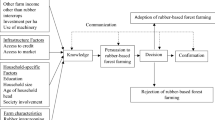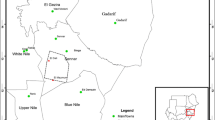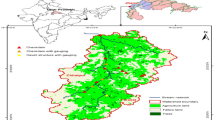Abstract
Rubber (Hevea brasiliensis) plays a vital role in livelihood development of smallholder farmers in Sri Lanka. However, farmers have to bear the absence of cash inflow during the 6–7 years long immature period. Therefore, most of the farmers adopt rubber-based agroforestry as a subsidiary source of income. This study focuses on the analysis of poverty incidence in the presence of different rubber-based agroforestry practices in Moneragala district, Sri Lanka. It uses the official poverty line for this district defined by the Department of Census and Statistics Sri Lanka to determine the poverty level of households. The study employs binary logistic regression to analyse the poverty incidence with selected household socio-economic variables and rubber-based agroforestry practices. Household characteristics, including education, other agricultural income, and non-farm income show a significant relationship with the reduction of poverty while the larger household size contributed to higher poverty. Probability of reducing poverty is highest in dairy cattle farming (97%) followed by groundnut (89%), pepper (85%), and cocoa (84%) agroforestry practices and they were found to be significant in poverty reduction at the household level. The study implies that rubber-based agroforestry options must be revitalised according to the poverty reduction abilities. At the same time, extension intervention with suitable institutional arrangement should address the need for rubber-based agroforestry practices, including banana, maize, and passionfruit. Findings of this study are, therefore recommended that government agencies should further focus on existing policies to introduce commercial crops to enhance the productivity and profitability of rubber lands. It is necessary to focus on the agricultural support programme for encouraging farmers to adopt groundnut, dairy cattle, pepper, and cocoa rubber agroforestry practices.


Similar content being viewed by others
Notes
Agro-ecological zones represent a particular combination of the climate, soil and relief. An agro-climatic map consists with the areas where the integrated effect of climate is uniform throughout the area for crop production superimposed with soil and terrain. Resulting map explains the agro-ecological regions and Sri Lanka is divided into 46 agro-ecological regions.
References
Abbott P, Murenzi I, Musana S (2012) The role of non-farm household enterprises in poverty reduction, employment creation and economic growth in Rwanda. Rwanda J 26:68–92
Akerele D, Momoh S, Adewuyi S, Phillip B, Ashaolu O (2012) Socio-economic determinants of poverty among urban households in south-west Nigeria. Int J Soc Econ 39(3):168–181. https://doi.org/10.1108/03068291211199341
Association for Natural Rubber Producing Countries (ANRPC) (2017) Monthly Statistical Bulletin 9:6
Archer KJ, Lemeshow S, Hosmer DW (2007) Goodness-of-fit tests for logistic regression models when data are collected using a complex sampling design. Comput Stat Data Anal 51(9):4450–4464
Arun S (1999) Does land ownership make a difference? Women’s roles in agriculture in Kerala, India. Gend Dev 7(3):19–27. https://doi.org/10.1080/741923248
Awan MS, Malik N, Sarwar H, Waqas M (2011) Impact of education on poverty reduction. Munich Personal RePEc. https://mpra.ub.uni-muenchen.de/31826. Accessed 21 May 2017
Bayudan-Dacuycuy C, Lim JA (2013) Family size, household shocks and chronic and transient poverty in the Philippines. J Asian Econ 29:101–112. https://doi.org/10.1016/j.asieco.2013.10.001
Birthal PS, Roy D, Negi DS (2015) Assessing the impact of crop diversification on farm poverty in India. J World Dev 72:70–92. https://doi.org/10.1016/j.worlddev.2015.02.015
Bleyer M, Kniivilä M, Horne P, Sitoe A, Falcão MP (2016) Socio-economic impacts of private land-use investment on rural communities: industrial forest plantations in Niassa, Mozambique. Land Use Policy 51:281–289
Chayal K, Dhaka BL, Poonia MK, Tyagi SVS, Verma SR (2013) Involvement of farm women in decision-making in agriculture. Stud Home Commun Sci 7(1):35–37
Che-Mat SH, Jalil AZA, Harun M (2012) Does non-farm income improve the poverty and income inequality among agricultural household in rural Kedah? Procedia Econ Financ 1:269–275
Cochran WG (1977) Sampling techniques, 3rd edn. Wiley, New York
Department of Census and Statistics (DCS) (2015) Poverty global practice. DCS, Battaramulla. https://www.statistics.gov.lk/poverty/SpatialDistributionOfPoverty2012_13.pdf. Accessed 21 May 2017
Department of Census and Statistics (DCS) (2017) Poverty indicators DCS, Battaramulla. https://www.statistics.gov.lk/page.asp?page=Poverty. Accessed 10 June 2017
De Silva I (2008) Micro-level determinants of poverty reduction in Sri Lanka: a multivariate approach. Int J Soc Econ 35:140–158
Douangsavanh L, Thammavong B, Noble A (2008) Meeting regional and global demands for rubber: a key to poverty alleviation in Lao PDR? The Sustainable Mekong Research Network (Sumernet). Pathumwan, Bangkok 10330, Thailand. https://lad.nafri.org.la/fulltext/2023-0.pdf. Accessed 15 June 2017
Dissanayake DMAP, Wijesuriya W, Abeywardene V (2005) Farmers’ perspectives: expectations and constraints faced by smallholder rubber farmers in Moneragala. Bull Rubber Res Inst Sri Lanka 46:70–79
Fan S, Chan-Kang C (2005) Is small beautiful? Farm size, productivity, and poverty in Asian agriculture. Agric Econ 32(s1):135–146
Haggblade S, Hazell P, Reardon T (2010) The rural non-farm economy: prospects for growth and poverty reduction. J World Dev 38:1429–1441. https://doi.org/10.1016/j.worlddev.2009.06.008
Hashmi AA, Sial MH, Hashmi MH (2008) Trends and determinants of rural poverty: a logistic regression analysis of selected districts of Punjab. Pak Rev 47(4):909–923
Hichaambwa M, Jayne TS (2014) Poverty reduction potential of increasing smallholder access to land. Working paper 83, Indaba Agricultural Policy Research Institute (IAPRI) Lusaka, Zambia. https://ageconsearch.umn.edu/record/171873/. Accessed 25 March 2018
Hosmer DW, Lemeshow S, Sturdivant RX (2013) Applied logistic regression, 3rd edn. Wiley, New York
Hougni DJM, Chambon B, Penot E, Promkhambut A (2018) The household economics of rubber intercropping during the immature period in Northeast Thailand. J Sustain For 37(8):787–803. https://doi.org/10.1080/10549811.2018.1486716
Huang J, Gao L, Rozelle S (2012) The effect of off-farm employment on the decisions of households to rent out and rent in cultivated land in China. China Agric Econ Rev 4(1):5–17
Janvry AD, Sadoulet E, Zhu N (2005) The role of non-farm incomes in reducing rural poverty and inequality in China. https://escholarship.org/uc/item/7ts2z766. Accessed 25 June 2017
Jessy MD, Joseph P, George S (2017) Possibilities of diverse rubber-based agroforestry systems for smallholdings in India. Agrofor Syst 91:515. https://doi.org/10.1007/s10457-016-9953-8
Kassie GW (2017) Agroforestry and farm income diversification: synergy or trade-off? The case of Ethiopia. Environ Syst Res 6:8. https://doi.org/10.1186/s40068-017-0085-6
Knight J, Shi L, Quheng D (2010) Education and the poverty trap in rural China: closing the trap. J Oxf Dev Stud 38:1–24. https://doi.org/10.1080/13600810903551595
Lopez R, Valdes A (2015) Fighting rural poverty in Latin America: new evidence of the effects of education, demographics, and access to land. J Econ Dev Cult Change 49:197–211
Mapila MATJ, Kirsten JF, Meyer F (2012) The impact of agricultural innovation system interventions on rural livelihoods in Malawi. Dev South Afr 29(2):303–315. https://doi.org/10.1080/0376835X.2012.675699
Min S, Huang J, Bai J, Waibel H (2017) Adoption of intercropping among smallholder rubber farmers in Xishuangbanna. China Int J Agric Sustain 15(3):223–237. https://doi.org/10.1080/14735903.2017.1315234
Montagnini F, Nair PKR (2004) Carbon sequestration: an underexploited environmental benefit of agroforestry systems. Agrofor Syst 61:281. https://doi.org/10.1023/B:AGFO.0000029005.92691.79
Ministry of Plantation Industries Sri Lanka (MPISL) (2015) Statistical pocket book. MPSIL, Battaramulla
Munasinghe ES, Rodrigo VHL, Gunawardena U (2014) Modus operandi in assessing biomass and carbon in rubber plantations under varying climatic conditions. Exp J Agric 50(1):40–58. https://doi.org/10.1017/S0014479713000410
Munasinghe ES, Rodrigo VHL, Jayathilake PMM, Piyasena NM, Iqbal SMM (2019) Livelihood capital improvements in the rubber growing community of the eastern province of Sri Lanka. In: Proceedings of the seventh symposium on plantation crop research, Sri Lanka, 5–6 Nov 2019
Oli BN, Treue T, Larsen HO (2015) Socio-economic determinants of growing trees on farms in the middle hills of Nepal. Agrofor Syst 89:765–777. https://doi.org/10.1007/s10457-015-9810-1
Owuor G, Ngigi M, Ouma AS, Birachi EA (2007) Determinants of rural poverty in Africa: the case of small holder farmers in Kenya. J Appl Sci 7(17):2539–2543. https://doi.org/10.3923/jas.2007.2539.2543
Pathiratna LSS (2006) Management of intercrops under rubber: implications of competition and possibilities for improvement. Bull Rubber Res Inst Sri Lanka 47:8–16
Pathiratna LSS, Perera MKP, Balasooriya CK (2007) Cinnamon (Cinnamomum verum J. press) intercropped under different inter-row spacing of rubber (Hevea brasiliensis Mull. Arg.): performance after rubber reach maturity. J Rubber Res Inst Sri Lanka 88:30–40
Peduzzi P, Concato J, Kemper E, Holford TR, Feinstein AR (1996) A simulation study of the number of events per variable in logistic regression analysis. J Clin Epidemiol 49:1373–1379
Pfeiffer L, López-Feldman A, Taylor JE (2009) Is off-farm income reforming the farm? Evidence from Mexico. Agric Econ 40(2):125–138. https://doi.org/10.1111/j.1574-0862.2009.00365.x
Rahman SA (2008) Women’s involvement in agriculture in northern and southern Kaduna state, Nigeria. J Gend Stud 17(1):17–26. https://doi.org/10.1080/09589230701838347
Rodrigo VHL, Stirling CM, Naranpanawa RMAKB, Herath PHMU (2001) Agrofor Syst 51(1):35–48. https://doi.org/10.1023/A:1006449230436
Rodrigo VHL, Iqbal SMM, Munasinghe ES (2009) Rural livelihood and rubber cultivation in eastern province of Sri Lanka. J Rubber Res Inst Sri Lanka 89:58–69
Rodrigo VHL, Iqbal SMM, Munasinghe ES, Balasooriya BMDC, Jayathilake PMM (2014) Rubber in east assures the perceived benefits; increased rubber production, amelioration of the climate and improved the rural livelihood. J Rubber Res Inst Sri Lanka 94:33–42
Rodriguez AG, Smith SM (1994) A comparison of determinants of urban, rural and farm poverty in Costa Rica. World Dev 22(3):381–397. https://doi.org/10.1016/0305-750x(94)90129-5
Sackey HA (2005) Poverty in Ghana from an assets-based perspective: an application of probit technique. Afr Dev Rev 17(1):41–61
Sellamuttu SS, Aida T, Kasahara R, Sawada Y, Wijerathna D (2014) How access to irrigation influences poverty and livelihoods: a case study from Sri Lanka. J Dev Stud 50(5):748–768
Somboonsuke B, Wetayaprasit P, Chernchom P, Pacheerat K (2011) Diversification of smallholding rubber agroforestry system (SRAS) Thailand. Kasetsart J Soc Sci 32(2):327–339
Spieldoch A (2007) A row to hoe. The gender impact of trade liberalisation on our food system, agricultural markets and women’s human rights. Institute for Agriculture and Trade Policy (IAIP)/International. Gender and Trade Network (IGTN): Friedrich-Ebert-Stiftung Geneva, Switzerland. https://www.files.ethz.ch/isn/47736/2007-01-01_RowToHoe_EN.pdf. Accessed 26 Sept 2017
Suvedi M, Ghimire R, Kaplowitz M (2017) Farmers’ participation in extension programs and technology adoption in rural Nepal: a logistic regression analysis. J Agric Educ Ext 23(4):351–371. https://doi.org/10.1080/1389224X.2017.1323653
Tillmanns S, Krafft M (2017) Logistic regression and discriminant analysis. In: Homburg C, Klarmann M, Vomberg A (eds) Handbook of market research. Springer, Cham
Vijayakumar S, Olga B (2012) Poverty incidence and its determinants in the estate sector of Sri Lanka. J Compet 4(1):44–55
Viswanathan PK, Shivakoti GP (2008) Adoption of rubber-integrated farm-livelihood systems: contrasting empirical evidence from the Indian context. J For Res 13:1–14
Wijesuriya W, Dissanayake A, Samarappuli L, Wijeratne M, Gunaratne K, Abewardena V (2008) Issues and perspectives of smallholder rubber farmers and possible solutions for sustainable rubber farming in Non-traditional rubber growing areas. In: Proceeding of the second plantation crop research symposium, Colombo, Sri Lanka, 17–18 Oct 2008
Wijesuriya W, Dissanayake DAMP, Herath HMLK, Gunaratne PKKS (2011) Constraints in sustainable smallholder rubber farming in the Moneragala district. J Rubber Res Inst Sri Lanka 91:61–74. https://doi.org/10.4038/jrrisl.v91i0.1853
Yogaratnam N (2001) Land suitability evaluation, selection and soil conservation. In: Tillekeratne LMK, Nugawela A (eds) Handbook of rubber, 1st edn. Rubber Research Institute, Agalawatta, pp 5–35
Yusuf SA, Adesanoye AO, Awotide DO (2008) Assessment of poverty among urban farmers in Ibadan metropolis. Nigeria J Hum Ecol 24(3):201–207. https://doi.org/10.1080/09709274.2008.11906155
Zellner D, Keller F, Zellner GE (2004) Variable selection in logistic regression models. Commun Stat Simul Comput 33(3):787–805. https://doi.org/10.1081/SAC-200033363
Acknowledgements
Authors wish to acknowledge Rubber Development Officers (RDO) in the Moneragala District, Sri Lanka for assisting in data collection. We appreciate the Farmers of the study area for their unreserved support during the survey.
Author information
Authors and Affiliations
Corresponding author
Additional information
Publisher's Note
Springer Nature remains neutral with regard to jurisdictional claims in published maps and institutional affiliations.
Electronic supplementary material
Below is the link to the electronic supplementary material.
Rights and permissions
About this article
Cite this article
Sankalpa, J.K.S., Wijesuriya, W. & Ishani, P.G.N. Do rubber-based agroforestry practices build resilience upon poverty incidence? A case study from Moneragala district in Sri Lanka. Agroforest Syst 94, 1795–1808 (2020). https://doi.org/10.1007/s10457-020-00502-9
Received:
Accepted:
Published:
Issue Date:
DOI: https://doi.org/10.1007/s10457-020-00502-9




